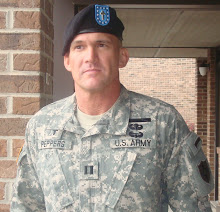For the past three weeks, I’ve been at the Camp Blanding Joint Training Center with my unit, for a five-week pre-mobilization trainup. Pre-mob means that we will be mobilizing soon, and deploying to Iraq after we mobilize. People who have not been in the military might not realize how many different and complicated tasks are required for one Soldier to fight. Most of what we have been doing out here has been Soldier-level or leader-level individual tasks: first aid, moving under fire, manning check points, calling for indirect fire, decontamination, radio communication, signaling, clearing rooms, reacting to contact, and many other combat-related tasks. The Soldiers of the 779th have had late nights and early mornings, with few breaks in the pace.
Some reporters from the Tallahassee Democrat stayed with us for a few days early on. They even wrote an article about the suicide prevention training I’m doing with them. You can find the article at http://www.tallahassee.com/article/20090330/NEWS01/903300315/1010. There is also a video interview with me to the right of the article, on the same page.
Since I’m the chaplain, I cannot carry a weapon, or train with one. Some have noted the irony that, while I wear Air Assault Wings, Parachute Badge, the Expert Infantry Badge and I’m one of three soldiers in the battalion to have a Ranger Tab, I can’t carry a weapon. So I carry a fork. That’s right, tucked in the loops of my IBA (Improved Ballistic Armor) vest is a plastic fork. It was one of our nice plastic forks from home. It looks like pewter. But we’re only training, so it’s plastic. I figure when we get in theatre, I might replace it with a real fork.
It’s really just a conversation piece, and not meant to be a weapon, really. But during a react to contact drill or something, I pulled out my fork while doing these three-to-five-second rushes. (They somehow require so much more effort now than they did twenty years ago). Not to be used as a weapon, mind you. After all, we all know the chaplain is a non-combatant. But I gotta eat.
I’m sad to report that the fork did not make it through all the training. It apparently got smashed between my IBA and the ledge of a window I had to crawl over. A sergeant found the pieces and brought them to me, gingerly holding them in his hands. “Here, Chappy,” he said, “It looks like your fork didn’t make it.” After that I went to carrying a plain old white plastic fork. It just wasn’t the same. Sure, we can get a new puppy.
Besides getting trained myself in whatever tasks don’t require me to engage the enemy (which includes most of them), I have also to care for the spiritual well-being of the Soldiers. Early in our training, I delivered a briefing in the “Maintaining Your Battle Focus” series. My part was “Staying Spiritually, Emotionally and Mentally Fit.” All in thirty minutes. Isn’t Power Point wonderful?
A little later, I had a more lengthy and interactive discussion with them on Combat Stress. It used to be that if a Soldier had battle fatigue, he became a pariah, and was labeled a coward or weak. Now, our approach is to recognize the signs of Combat Stress early, and then get the Soldier a little rest, some hot chow, and maybe a few hours out of the thick of things. (All this is if the situation allows this, as it usually does.) Getting the Soldier to talk about his feelings and getting him back to normal things is part of the healing process. Most soldiers don’t require evacuation out of the combat zone, just a little rest. Of course, more severe cases of Combat Stress require treatment. But most Soldiers with Combat Stress—70 to 85%—can be returned to their combat units within three days.
There are two other related areas I am responsible for training as we prepare to go to war. I’ll talk more later about suicide prevention and preparing the Soldiers’ minds for what they might encounter during “Battlemind” training.
Wednesday, April 8, 2009
Subscribe to:
Posts (Atom)





